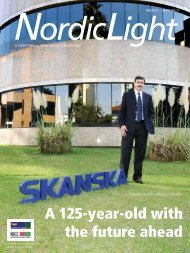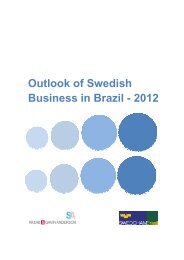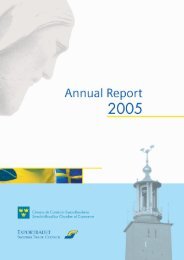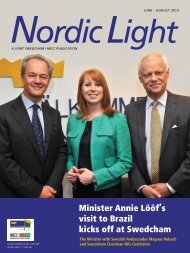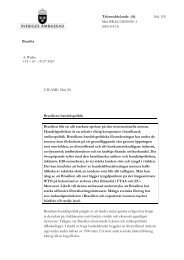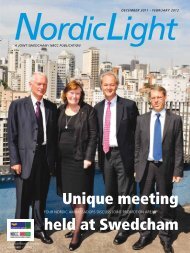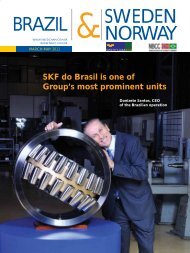Brazil Is Volvo Cars' Fastest Growing Market Worldwide
Brazil Is Volvo Cars' Fastest Growing Market Worldwide
Brazil Is Volvo Cars' Fastest Growing Market Worldwide
You also want an ePaper? Increase the reach of your titles
YUMPU automatically turns print PDFs into web optimized ePapers that Google loves.
16<br />
Developing leadership<br />
in international<br />
organizations<br />
By Therese Otterbeck*<br />
Why should an organization<br />
invest resources and<br />
time in leadership development?<br />
<strong>Is</strong> this question<br />
still valid or have most organizations come<br />
so far that leadership development is part<br />
of their framework? The opinions will most<br />
likely differ, but many of us agree that effective<br />
leadership development is essential<br />
to any business today—the main reason being<br />
that leadership skills that worked well in<br />
the past are quickly becoming outdated in<br />
today’s fast-paced world. To be effective as a<br />
leader in today’s business environment, one<br />
needs to have a great deal of self-awareness<br />
and know-how to constantly adapt to and<br />
drive change.<br />
Organizations are complex: they are populated<br />
by people whose behavior is hard to<br />
predict. Large organizations normally include<br />
a complex range of people, departments,<br />
technologies and goals which, in itself, is<br />
an open system dealing with a constantly<br />
changing, challenging and unpredictable environment.<br />
How can the so important lessons and<br />
learnings be extracted? It is not easy, yet the<br />
rapidly shifting business scenario requires<br />
organizations to learn better and faster.<br />
The core challenge of leadership is to be<br />
able to fi nd the direction, to defi ne a vision,<br />
and lead the organization towards its goals.<br />
Very few leaders will have all the talents and<br />
skills needed to succeed, but self-awareness<br />
and recognition of individual strengths and<br />
weaknesses are certainly the fi rst two ingredients<br />
to look out for.<br />
Most managers, to become leaders fully<br />
equipped to deal with today’s business challenges,<br />
need regular injections of development<br />
interventions. It is clear that organizations<br />
which develop leadership skills within<br />
a strategic context and in a routinely disci-<br />
JUNE - AUGUST 2010<br />
plined manner will experience a positive impact<br />
on the business result. The leaders of an<br />
organization determine whether it succeeds<br />
or fails. They need the skills to defi ne the<br />
strategy for their organization, they need<br />
to inspire others to follow, and successfully<br />
meet their mission objectives.<br />
Given its importance and critical aspects,<br />
the next question is who should take part in<br />
a leadership development program?<br />
Identifi cation of participants should be<br />
carried out by business managers together<br />
with HR professionals, using job performance<br />
reviews as well as other signifi cant<br />
information, which could be informal feedback<br />
from direct managers and colleagues.<br />
Some of these individuals should naturally<br />
be included in the organization’s succession<br />
plan and, if possible, be assigned a mentor<br />
within the organization to further increase<br />
support and learning. A strategic approach<br />
to leadership development helps an organization<br />
determine if it has the right people,<br />
with the right skills, and in the right positions.<br />
Leadership development is not only<br />
important for individuals, but critical for<br />
organizational success—both for now and<br />
for the future.<br />
Most leadership development programs,<br />
in-company or external, would typically<br />
include information and exercises on selfawareness,<br />
feedback, group work, personal<br />
refl ection, business cases, vision, mission,<br />
and strategy, one-to-one coaching, and action<br />
planning and projects. Delivery methods<br />
for management or leadership development<br />
should be mixed, using a blended<br />
learning approach: institutional (classroom<br />
based), experiential learning, coaching, action<br />
(on-the-job) learning and 360-degree<br />
feedback.<br />
The most common objectives for leadership<br />
development are the ability to engage<br />
and retain individuals with high potential, the<br />
ability to improve general pipeline strength<br />
for executive level positions and succession<br />
planning, the development of leadership<br />
competencies, the increase of self-awareness<br />
among the leaders, and fi nally the development<br />
of strategic thinking skills through a<br />
better understanding of the business model.<br />
By providing a larger, more appropriate<br />
pool of internal candidates, thus creating a<br />
strong leadership infrastructure, an organization<br />
reduces its need to go outside to fi nd<br />
potential candidates for strategic positions.<br />
This, in turn, reduces the costs and increases<br />
the effectiveness of recruiting and selection.<br />
Development and promotion from within<br />
are one of the most meaningful parts of an<br />
employer-of-choice culture and a powerful<br />
motivational tool.<br />
Today’s business world requires a leadership<br />
approach that is very diverse. Good<br />
leaders know that the very existence of differences<br />
is vital in any management team.<br />
Leaders today, as well as in the future, will<br />
have to struggle with a complex, rapidly<br />
changing environment with diffi cult problems<br />
on many fronts. No individual will be<br />
able to shape the best answers alone. Investing<br />
in strategic leadership development programs,<br />
making sure the participants of these<br />
programs have strong support from their<br />
managers and mentors within the organization,<br />
will have a positive and lasting impact<br />
on results and help develop and retain high<br />
performing employees—those employees the<br />
market is fi ghting for and somehow guarantee<br />
future success.<br />
* Therese Otterbeck is an Organizational Development<br />
Consultant and the new Coordinator of<br />
Swedcham’s Human Capital Committee.



